ChatGPT: A Mutation Engine for Ideas
How the work which led to the 2018 Nobel Prize in Chemistry can provide a template for effectively using AI tools
I’ve thinking a lot about ChatGPT recently and how to best use it as a ladder instead of a crutch. One way that I see AI tools like ChatGPT being useful right now is for helping with ideation and brainstorming.
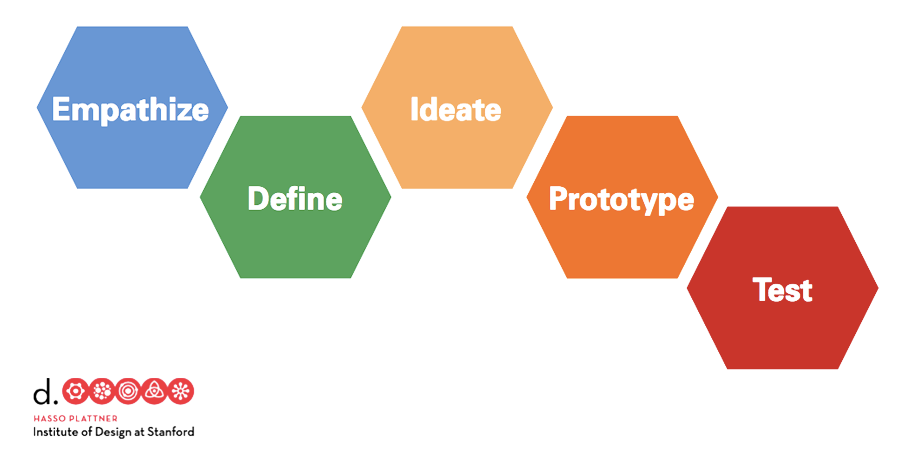
The ideation phase of the design process is a critical step in ensuring that the best possible solution is built. Whether the end product really addresses the problem at hand is in large part a function of how well the designer empathizes with the client and defines the problem, but once the problem is correctly identified and described, the final steps of the process (ideate, prototype, and test) form the execution pipeline that ultimately creates the product.
While I agree with those who argue that ChatGPT can’t truly create new knowledge (by definition it can only generate outputs based on the data it was trained on), I think that it can be an excellent tool for creativity by mutating ideas and breaking us out of tunnel vision and ruts in our own thinking.
Quantity as an avenue to quality
When I was a grad student at Caltech, I was fortunate to be able to take a introduction to graphic design course at Art Center College of Design. This was a fantastic experience and taught me so much about how practitioners from a discipline outside of the engineering context think about the process of design.
One of the assignments that stuck with me from taking that class was part of a project designing a logo for a brand. The assignment required that we draw no fewer than 100 thumbnail-sized sketches of our design ideas, starting from some obvious ideas and then iteratively making tweaks.
Whether you think that 100 thumbnails is a lot probably depends mostly on whether you've ever tried this exercise before. If not, try it, and you'll find out pretty quickly that coming up with new ideas after about 15 is hard and feels like hitting a mental wall. After about 20-25 it seems impossible. Often you need to take a break and come back later just to get inspiration about other things to change. But the sheer quantity of ideas is key—the breadth and variation of the brainstorming process ensures that you explore a broad landscape and uncover the best possible solutions.
It is in this process of breaking through creative blocks that I think AI tools like ChatGPT can be very helpful. While ChatGPT is not always factually accurate, the beauty of the brainstorming process is that there are no wrong ideas. Even a crazy and obviously impossible idea can unlock a whole new line of thinking.
In a more formal framework, AI-assisted brainstorming tools are analogous to an idea generation engine which we can use to generate a wide array of different possible solutions. Then, we can filter the ideas and feed the most interesting ones back to the AI in order to hone in on what we are thinking.
If the forward problem is hard, try sidestepping
This process is not unlike the directed evolution, a technique used to design proteins—bringing me back to another connection I made during my time at Caltech. During my PhD I was part of the Caltech Biotechnology Leadership Program, a program funded in part by the National Institutes of Health (NIH) and the Donna and Benjamin M. Rosen Bioengineering Center at Caltech. Through this program I connected with other Caltech students in biology and chemistry and also had the opportunity to get to know Frances Arnold, the program's faculty director. This week as I reflected on effective ways to use ChatGPT, I was reminded of Dr. Arnold and how generating ideas with ChatGPT parallels a tool in her Chemistry toolbox.
In 2018, Dr. Arnold was awarded the Nobel Prize in Chemistry for her work pioneering a the use of directed evolution to engineer new enzymes, a specific class of proteins that catalyze chemical reactions. Traditionally, chemists seek to synthesize proteins using a process called rational design, trying to predict how a molecule’s structure will affect its behavior. Directed evolution takes a different approach. Instead of trying to solve the forward problem and figure out how the structure of the molecule influences its behavior, directed evolution works by generating a library of mutated genes and then screening the resulting proteins according to desired metrics. This process has been extremely powerful for generating new proteins for all sorts of applications, including the chemical processes used for developing pharmaceuticals and renewable fuels.
Directed evolution for your ideas
Directed evolution provides a valuable framework that we can apply to using AI tools like ChatGPT for creativity. The underlying process of generating lots of different mutations and then filtering or screening them for the best ideas, repeating this process iteratively to generate better and better ideas is not new. In many ways, this is the goal of the diverging and converging mindsets that are taught all over in design, both in engineering and artistic fields. However, the difference is that ChatGPT provides us with a new superpower for easily generating creative new ideas, something that humans often struggle to do since we get stuck in mental ruts.
This plays into our strength. In general, it is easier to filter out bad ideas than come up with good ones from scratch. This structure also counters one of the main weaknesses of tools like ChatGPT which is its inability to provide ideas which are grounded in reality or factually correct. In an engineering design context, proving whether the proposed solution will work is part of the prototyping and testing process. While ChatGPT might generate some crazy ideas that are simply not feasible, these will be naturally weeded out as we filter the list and select only a few candidates for future exploration. Here the iterative nature of ChatGPT that allows us to ask it to build or expand on text that it has previously generated is another key advantage when compared to using a tool like a search engine.
AI tools for thought
Applications like this make me excited and optimistic about the impact that AI tools like ChatGPT will have and explain why I think that there are many opportunities to use them to extend our human capabilities instead of replacing them.
The hard work of actually making the idea a reality will still require that we understand the fundamental science and engineering concepts. But tools like ChatGPT we can boost our creativity as a conversational muse to expand our minds and help us make connections that we may never have seen otherwise.
Directed evolution forever changed not only the process of developing proteins, but, perhaps more importantly, the way that we think about engineering proteins. I think AI tools like ChatGPT are just the first salvo in a new class of tools for changing the way we think about engineering new ideas.
My favorite ChatGPT uses right now
Here are a few examples of the types of things that I’ve been playing around with lately:
Generating startup ideas: here I brainstorm an escape room with music-themed puzzles.
A baking assistant: we Americans seem to be stuck on measuring by volume. It’s a pain and innacurate. Now ChatGPT is my baking assistant. I paste in the recipes and ask it to convert all quantities to mass so that I can easily measure them out by mass on my kitchen scale. It works amazingly well!
Writing Excel functions: I got stuck trying to figure out how to make my grading rubric work last week. ChatGPT to the rescue. A single (poorly worded, I might add) prompt and ChatGPT fed me back a function that did EXACTLY what I wanted.
The Book Nook
This week I read Why They Can't Write: Killing the Five-Paragraph Essay and Other Necessities by John Warner. I had stumbled upon John’s work on Twitter when I saw his tweet sharing his article about the impact of ChatGPT on education.
This book inspired me to revisit my own motivation and framing for writing and to double down on my embrace of the process of writing, embracing the failure that inevitably comes alongside consistent practice and experimentation with new skills.
Along the way I found myself deeply resonating not only with John’s thoughts on developing the practice of writing, but also his general approach to pedagogy. This approach, centered on a respect for the process of learning and emphasizing the alignment of incentives and assessment with the development of the process is a part of what it means to sustainably grow in any pursuit.
A few specific quotes that resonated:
My goals for students were too low, settling for proficiency rather than insisting on a process directed toward consistently and continually building expertise, not only in the class but beyond. I now recognize that deep learning, lasting, transferable knowledge, requires each individual to reinvent the wheel for themselves. Previously, I was giving students not just the wheels, but the entire car to go with them. At best, they were buying the gas.
A good reminder that we aren’t doing our students any favors by giving them the answer. Instead, we should focus on helping them develop the practices and processes that lead to a flourishing intellectual life.
I have no wish to impose a grand pedagogy, but I do believe that when we assign writing we need to be consistently more thoughtful about what we’re asking students to do and why we’re asking them to do it. If we focus on experiences rather than proficiencies, I believe students will learn.
Speaking my language. A lot of alignment here with my commitment to transparent teaching.
Learning to write is a process, not a product. There is no finish line, only the ongoing work to keep developing the writer’s practice.
Amen. I would add that this applies to almost any endeavor. Developing valuable skills takes time and requires consistent effort over sustained intervals.
I’m looking forward to reading one of John’s other books The Writer’s Practice and am enjoying his other writing on Substack and his blog at Inside Higher Ed.
The Professor Is In

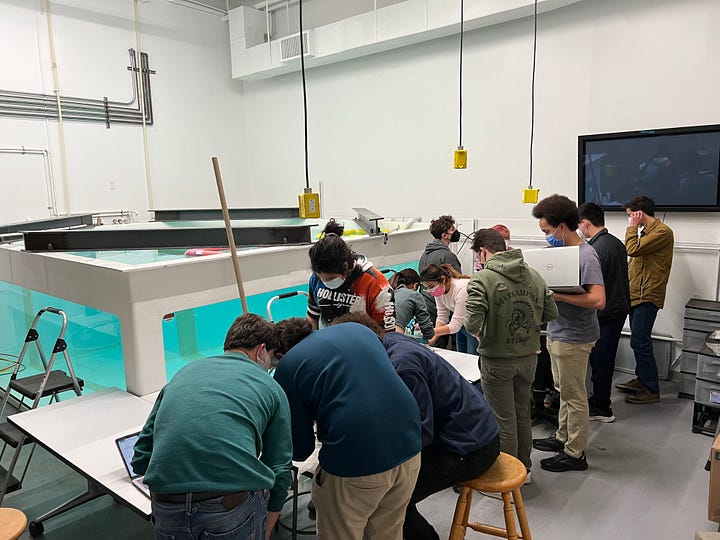
Last week was our first lab in E80. Right off the bat, students assemble their robots and launch them in the tank to capture some data using their on-board accelerometer. The class is off to a raring start and it’s always great fun to see the energy and enthusiasm that students bring.
The photos above show the students working in the lab space getting components to solder and test their motherboards and then in the tank room where they launch them in the water to capture data.
Leisure Line

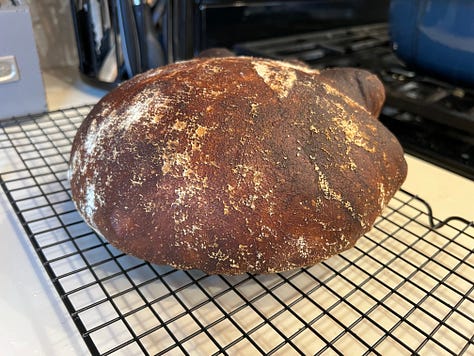
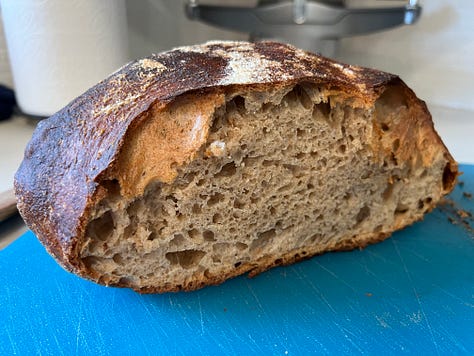
I’ve been tinkering with bread for a little while now but wanted to try out a new recipe. This first attempt at the 40% wheat bread from Ken Forkish’s Flour Water Salt Yeast turned out pretty great. Hard to beat the taste and smell of fresh bread!
Still Life
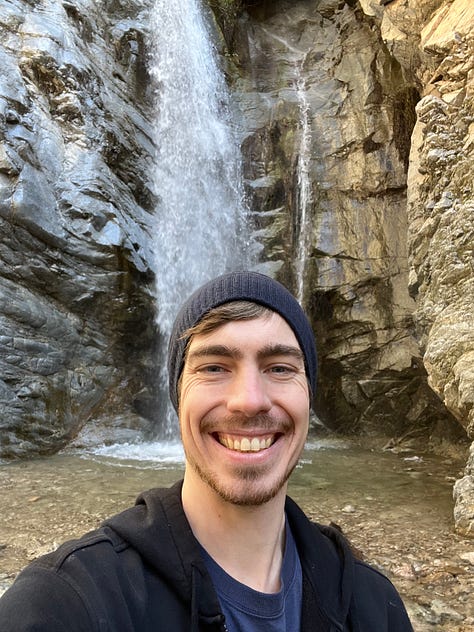

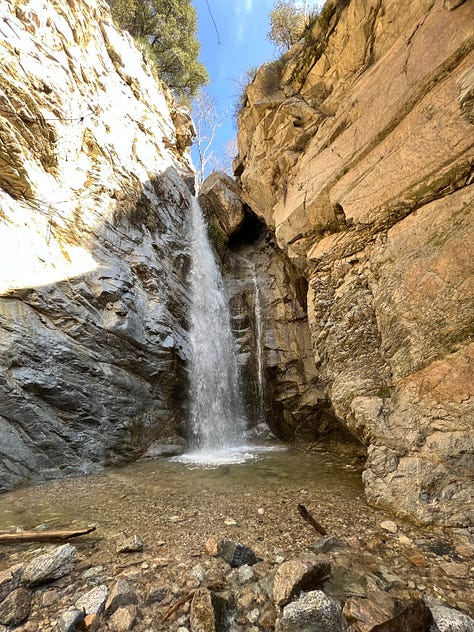
After all the rain recently, the waterfall at Millard Falls was really rip-roaring this last weekend. I was glad I wore my trusty Chacos as there were lots of water crossings. Apparently someone had posted about the falls on social media this last week so there were TONS of people there. Cars parked all the way up the road like I’ve never seen.



